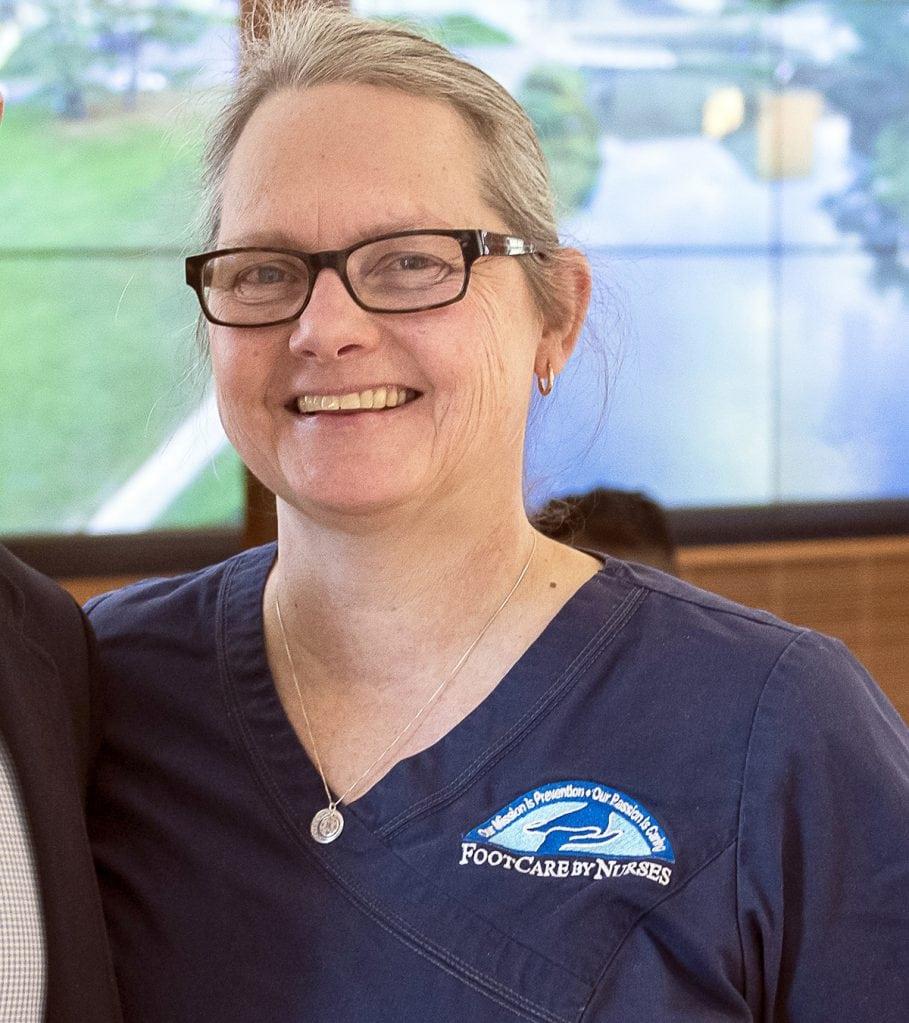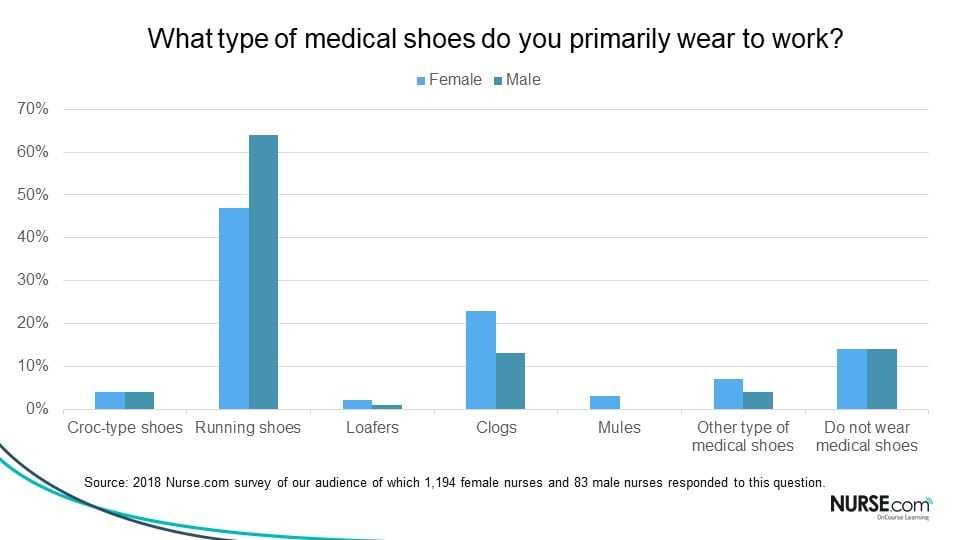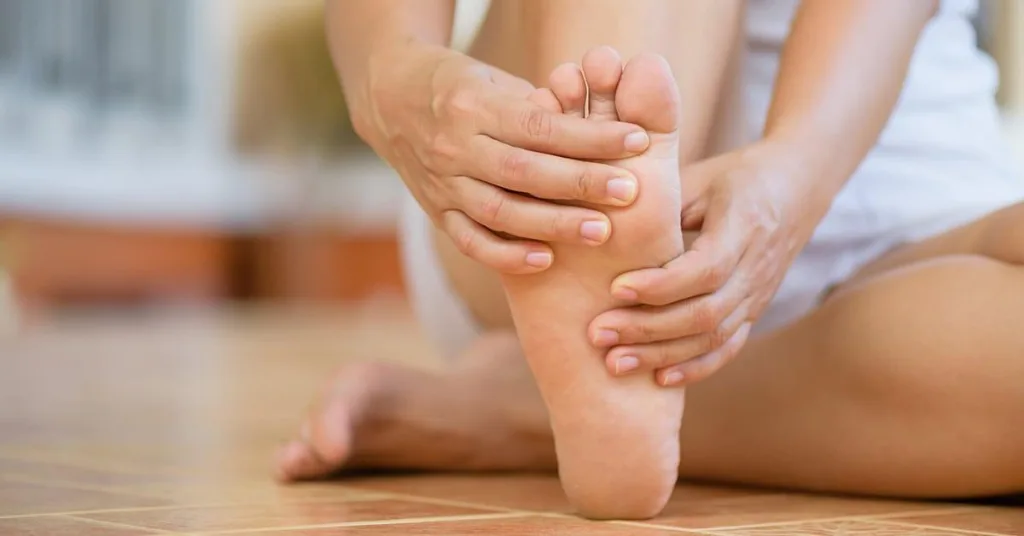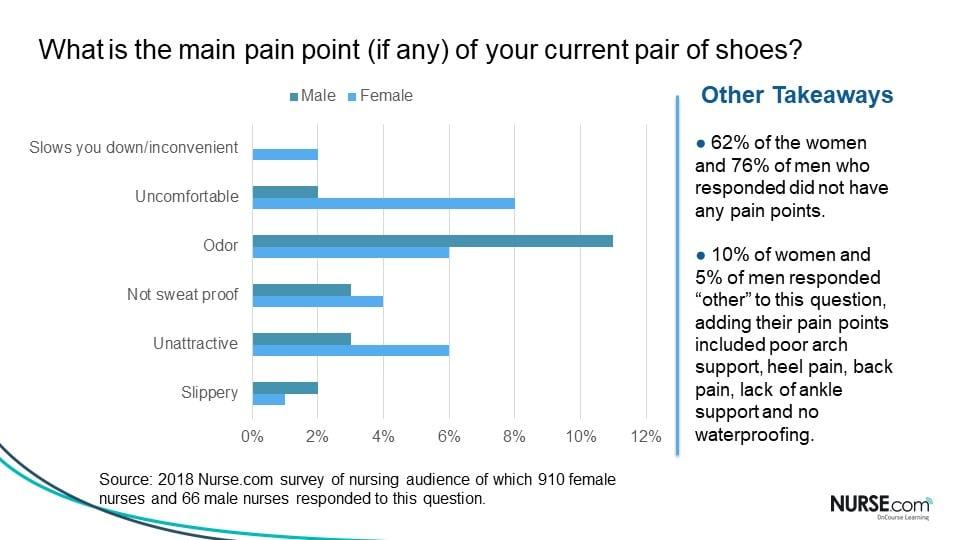Experts focus on nursing shoes and proper foot care for solutions to back, knee, and foot pain. Three years ago, 55-year-old Erika Hussain, RN, was in so much pain from being on her feet 32 hours a week she considered retiring early. Although she enjoyed working at Berkshire Medical Center in Pittsfield, Mass., Hussain had resorted to wearing five insoles in her left shoe to minimize the back and knee pain she experienced every day on the unit.
"I felt like a cripple," she said.
One day, she casually talked about her discomfort with another nurse, Kate Clayton-Jones, MSN, MBA, RN, who offered to perform an evaluation to better understand the source of Hussain's pain.
Evaluating the source of pain
Clayton-Jones asked Hussain to take off her shoes and socks, watched her walk and looked for corns, calluses and other possible sources of pain. Then she picked up Hussain's shoes. [caption id="attachment_53929" align="alignleft" width="200"] Kate Clayton-Jones, RN[/caption]
Kate Clayton-Jones, RN[/caption]
"I saw that the sole was too flexible, the shoes were not laced effectively to hold her heel in place and she was wearing the wrong type of shoe for walking on concrete every day," said Clayton-Jones, owner of FootCare by Nurses in Greenfield, Mass.
She suggested Hussain experiment with nursing shoes that would better support her feet, and the next day Hussain bought a pair normally used for hiking. She noticed the difference immediately. "I started walking better -- straighter without nearly as much pain in my knee -- and I even started walking after work for exercise," Hussain said. "She saved my career." As word started spreading at the hospital that Clayton-Jones was an expert in foot care, she started meeting more nurses who complained about pain in their legs, backs, and feet. She was convinced many of these problems could be remedied or even prevented with proper foot care.
How to find the right shoes
According to a recent survey we conducted, 8% of female nurse respondents and about 2% of male respondents reported discomfort as the main pain point of their nursing shoes. Although pain often motivates people to change their behavior, Clayton-Jones believes it's important to start practicing good foot care habits before discomfort begins. One common mistake that leads to pain is improper shoe sizing, said Kristin Heisler, BSN, RN, CFCS, who works for FootCare by Nurses. "I often treat people who haven't had their feet measured for years," Heisler said. "And they are often wearing the wrong size."
When shoes are slightly too large, the foot can slip forward in the shoe and the toes may curl to hold it in place. When shoes are too small, the toes can overlap, which increases the risk of calluses. Toes need to spread out to facilitate proper balance, Heisler said.
Clayton-Jones also encourages nurses to buy shoes made for walking and standing rather than running.
"The running step is a very different motion than walking or standing," she said. "Running shoes are designed with a higher heel that propels someone forward, but a forward pitch puts nurses off balance for hours at a time."
Running shoes also are designed to last 400 or 500 miles, which means many nurses would need to replace them after only seven to nine weeks. Instead, she recommends that nurses use shoes with heavier soles that can absorb the impact of walking on concrete for many miles each week, such as hiking shoes. 
The benefits of arch support
[caption id="attachment_53931" align="alignright" width="200"] Julia Overstreet[/caption] Although the right nursing shoes can ameliorate certain problems, sometimes foot pain is caused by bio-mechanical issues. So proper foot care goes beyond shoes. One common condition nurses experience is plantar fasciitis, or inflammation of the thick band of tissue that connects the heel bone to the toes, said podiatrist Julia Overstreet, DMP, FAPWCA, director of the American Foot Care Nurses Association in Bellevue, Wash. A tell-tale sign of plantar fasciitis is stabbing pain in the heel with the first few steps in the morning, and the pain may return after long periods on the feet. The discomfort is usually the result of pressure placed on the plantar fascia, and wearing arch supports for four to six weeks can often remedy the problem -- as long as nurses wear them at all times except in bed or in the shower, Overstreet said. Some nurses choose to continue wearing the inserts even after this initial period of healing to reduce the chance of recurring pain.
Julia Overstreet[/caption] Although the right nursing shoes can ameliorate certain problems, sometimes foot pain is caused by bio-mechanical issues. So proper foot care goes beyond shoes. One common condition nurses experience is plantar fasciitis, or inflammation of the thick band of tissue that connects the heel bone to the toes, said podiatrist Julia Overstreet, DMP, FAPWCA, director of the American Foot Care Nurses Association in Bellevue, Wash. A tell-tale sign of plantar fasciitis is stabbing pain in the heel with the first few steps in the morning, and the pain may return after long periods on the feet. The discomfort is usually the result of pressure placed on the plantar fascia, and wearing arch supports for four to six weeks can often remedy the problem -- as long as nurses wear them at all times except in bed or in the shower, Overstreet said. Some nurses choose to continue wearing the inserts even after this initial period of healing to reduce the chance of recurring pain.
Picking the right insert also is critical, and the best strategy is to sit down, cross the legs and hold up an arch support to the foot that is off the floor. If the insert matches the natural shape of the arch, this maximizes the chances of healing.
Podiatrists also can provide orthotics that are specifically designed for an individual's foot. Three dimensional scanners can create precise images that help podiatrists create personalized orthotics. "We can make so many modifications like dispersion padding in the forefoot or specific cushioning in the heel or arch based on the needs of the patient," said podiatrist Alan Bass, DPM, past president of the New Jersey Podiatric Medical Society. Orthotics also can reduce the risk of developing bunions, or bony bumps that form on the joint at the base of the big toe, Overstreet said.
"People often think this is caused by shoes, but it's often the result of loose ligaments in the foot," she said.
The importance of maintaining blood flow
[caption id="" align="alignleft" width="300"] Tamika Saunders, RN[/caption] Swelling in the feet and legs is another common consequence of working on the feet all day, and knee-high compression socks are a simple solution to this problem, Overstreet said. She suggests that nurses use socks that are 15-20 mmHG (millimeters of Mercury). Higher levels of pressure may be uncomfortable and lower levels may not prevent swelling. "Nurses who wear support hose will feel better at the end of the day and will decrease their risk of varicose veins," she said. Foot care specialist Tamika Saunders, AGACNP, RN, owner of Priority Feet in Grayson, Ga., suggests nurses also take time to soak their feet in warm water with Epsom salt for about 10 to 15 minutes after work to loosen tight muscles, which can decrease inflammation and soreness in the feet. Although spending time and money on proper foot care may seem like a low priority compared to other daily demands, nurses like Saunders have seen the ramifications of neglecting this part of the body. "We learn to take care of our eyes, our teeth, our hypertension, but we rarely take care of our feet until something serious develops," she said. "If nurses start focusing more on foot care, there are ways to alleviate pain that we have become accustomed to living with on a daily basis." Consider these tips for proper foot care and shoe choices to make your job more comfortable and keep you healthy.
Tamika Saunders, RN[/caption] Swelling in the feet and legs is another common consequence of working on the feet all day, and knee-high compression socks are a simple solution to this problem, Overstreet said. She suggests that nurses use socks that are 15-20 mmHG (millimeters of Mercury). Higher levels of pressure may be uncomfortable and lower levels may not prevent swelling. "Nurses who wear support hose will feel better at the end of the day and will decrease their risk of varicose veins," she said. Foot care specialist Tamika Saunders, AGACNP, RN, owner of Priority Feet in Grayson, Ga., suggests nurses also take time to soak their feet in warm water with Epsom salt for about 10 to 15 minutes after work to loosen tight muscles, which can decrease inflammation and soreness in the feet. Although spending time and money on proper foot care may seem like a low priority compared to other daily demands, nurses like Saunders have seen the ramifications of neglecting this part of the body. "We learn to take care of our eyes, our teeth, our hypertension, but we rarely take care of our feet until something serious develops," she said. "If nurses start focusing more on foot care, there are ways to alleviate pain that we have become accustomed to living with on a daily basis." Consider these tips for proper foot care and shoe choices to make your job more comfortable and keep you healthy.
Take these courses to focus on your self-care:
Nurse, Take Care of Thy Self (1 contact hr) Nursing is a stressful profession! Nurses are known for taking care of others at the cost of their own well-being. Lack of self-care can lead to compassion fatigue, personal health issues, and a lack of work life balance. When a nurse takes the time to care for themselves, both their colleagues and patients will reap the benefit. As easy as it sounds, it can be hard to create a work-life balance, exercise, and be a nurse role model. When pursuing continuing education or a new professional role, self-care and time management are key to helping yourself be successful. Work Life Balance: Learning to Say "No" Strategically! (1 contact hr) Leadership and management roles are highly stressful, and the more we take care of others, the less time we take care of ourselves. Lack of self-care can lead to compassion fatigue, personal health issues and deteriorating relationships with your staff. However, as the leader, we need to walk the talk and demonstrate work life balance to our staff. As nurses, we tend to say yes to everything. Learning to say "no" is hard. In this webinar, learn how to say "no" strategically in order to create work life balance. From 'Distress' to 'De-stress' With Stress Management (1 contact hr) A stress response causes specific biological changes, such as increased heart rate, bronchodilation, horripilation (goose bumps), increased blood pressure, increased sweat production, decreased immune response, decreased insulin and increased blood glucose. The volume of research in this area is growing rapidly, and it is safe to conclude that immune modulations caused by psychosocial stressors or interventions directly affect health outcomes. In the 2011 American Nurses Association survey of health and safety concerns, 74% of nurses reported effects of stress and overwork as their number one concern. This result is up slightly from the 2001 survey. A recent publication reports that nurses experience high levels of workplace stress with negative effects on both individual nurses and the organizations that employ them. This module provides information to help healthcare professionals manage their own stress and patients' stress.







